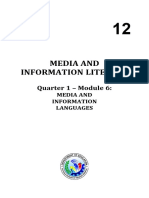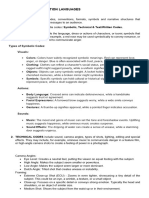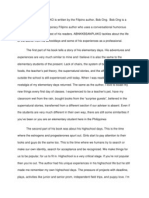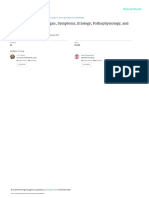Lesson Plan English Year 7
Lesson Plan English Year 7
Uploaded by
api-263589893Copyright:
Available Formats
Lesson Plan English Year 7
Lesson Plan English Year 7
Uploaded by
api-263589893Original Title
Copyright
Available Formats
Share this document
Did you find this document useful?
Is this content inappropriate?
Copyright:
Available Formats
Lesson Plan English Year 7
Lesson Plan English Year 7
Uploaded by
api-263589893Copyright:
Available Formats
Lesson Plan
Year Level: 7
Date/Time: 28.08.14
Learning Area/ACARA focus: English
Lesson Focus: Visual Literacy Image Analysis
Class Size: 6
Duration of Lesson: 20 minutes
Background information:
- Students have already been analysing images based on SWAT analysis (
except for A audio codes)
Teaching/Learning Purpose(s) (written in terms of outcomes):
Curriculum: English
Identify and explore ideas and viewpoints about events, issues and characters
represented in texts drawn from different historical, social and cultural
contexts (ACELT1619)
- Be able to complete 2 pictures using SWAT analysis( except for A audio
codes)
- Identify aspects of SWAT ( Symbolic, written, and technical codes)
Preparation:
- Print out 1 image for the students to complete, using the SWAT analysis(
except for A audio codes)
Learning Experiences:
1. How will I engage the learners?
- Interact with the students, ask them questions and allow them to frequently
respond.
- Use Images that the kids are familiar with
- Use visual stimuli for increasing novelty in the learning task
- Use students to teach other students.
2. Student tasks and activities (What will the students do to achieve the lesson
purpose(s)?)
- Complete 1 image all together on SWAT analysis
- Have an Example for them to understand what they will need to write for their
assessment
3. Conclusion (How do you summarise the learning and relate it to the lesson
purpose(s)?)
- I can evaluate by viewing their images and their analysis of them.
- You will be able to judge whether they understand by the answers to the
questions you have asked.
4. Assessment and evaluation: (How do you know the students have achieved
the learning purpose(s)? Evaluate your own performance.)
- I can evaluate by marking their images and checking their answers to see if
they understand.
- I can evaluate myself by observing their actions and writing a reflection on
how they approached the activities.
Codes and conventions in film help us to get the message that the director is
passing onto us.
Symbolic Codes: The secondary meaning represented by particular objects or symbols in the
film. We can find symbolism in objects (such as a cross symbolising Christianity), setting (beach
symbolising reflection, contemplation), costumes (designer suit symbolising someone who is very
well off, important), colours (black symbolises evil, white symbolises peace and purity) and many
more.
The symbolic meaning of elements of the film helps to add a deeper layer of meaning to the film
as a whole. Symbolism often allows the film to comment on the world as a whole, rather than
just the small world of the film.
Written Codes: Any text that appears on the screen, either as a part of the film itself (product
names, signs, newspapers) or through credits, subtitles etc.
Written codes can often communicate specific information more easily than visuals. For
example, if it is very important that the viewer know the exact setting of the film, the name of
the town or country will flash on the screen as a subtitle when we first cut to that setting. This
setting may have some symbolic significance, so the written code ensures we know where it is.
Audio Codes: Any sound that we hear throughout the film, such as dialogue, music, sound
effects, laugh tracks or applause.
Dialogue assists in character and development, while music helps to set the mood of a scene.
Sound effects are used to make the film seem real (our world is never silent, there is always
background noise) or to add to the emotion of a scene (for example, a creaking door in a horror
film adds to the suspense.)
Technical Codes: Techniques used in the construction of the image. For example: camera shots,
camera angles, camera movement, lighting, special effects.
Technical codes are used because of deliberate choices by the film producers to construct
scenes in a particular way. For example, in order to convey the person in position of power in a
scene, he will film with different angles on characters to show who is in control and who is
weaker or submissive. This assists in the characterisation and plot of the film.
In this picture we can identify the following symbols and some possible connotations.
Type of symbol Symbol Possible connotations
colours blue shadows
white clothes
white eyes
mysterious, unreal
clean, sterile
creepy, inhuman,
eyeless
objects test tube
glasses
science,
experimentation
learning, intelligence
body language straight lips
hand clasped firmly
humourless, serious
determination,
intensity
clothing white, collarless shirt scientist, doctor
You might also like
- Brain Based Therapy For Anxiety - A Workbook For Clinicians and ClientsDocument136 pagesBrain Based Therapy For Anxiety - A Workbook For Clinicians and ClientsCalvin Kao100% (3)
- Sound Design for Filmmakers: Film School SoundFrom EverandSound Design for Filmmakers: Film School SoundRating: 5 out of 5 stars5/5 (4)
- CM List of HabitsDocument7 pagesCM List of HabitsBrandy Campbell100% (14)
- Grade 6 English Module 2 FinalDocument29 pagesGrade 6 English Module 2 Finalmarilou cuntapay91% (34)
- Media and Information LanguageDocument20 pagesMedia and Information LanguageSandy NajeNo ratings yet
- Media and Information LanguagesDocument24 pagesMedia and Information LanguagesjamelahdanielleNo ratings yet
- Digital Media Literacy Credible Sources Education Presentation in Green Black Yellow Graphic StyleDocument26 pagesDigital Media Literacy Credible Sources Education Presentation in Green Black Yellow Graphic StylehannahtanawitNo ratings yet
- MIL Module 6Document4 pagesMIL Module 6Helner TaghapNo ratings yet
- Unit V-Film StudiesDocument4 pagesUnit V-Film StudiesshutupiqraNo ratings yet
- Module 6 HandoutsDocument4 pagesModule 6 HandoutsBarry AllenNo ratings yet
- English 5 - Media and Information LanguagesDocument34 pagesEnglish 5 - Media and Information LanguagesDean JandayanNo ratings yet
- Media and Information Language Final 1Document62 pagesMedia and Information Language Final 1Mel MagsayoNo ratings yet
- Cot Q1 Mil Media Info LangDocument85 pagesCot Q1 Mil Media Info Langbonetekent8No ratings yet
- Media & Information Literacy: Quarter 1 - Module 7Document13 pagesMedia & Information Literacy: Quarter 1 - Module 7Arcee CagampanNo ratings yet
- Assigned Topics For EachModule 6 Media and Information Languages For Written Report andDocument7 pagesAssigned Topics For EachModule 6 Media and Information Languages For Written Report andLhiwell MiñaNo ratings yet
- Claymation AssignmentDocument7 pagesClaymation AssignmentGrayson AllensworthNo ratings yet
- Film PPT AssignmentDocument2 pagesFilm PPT AssignmentRaissa KimbulaNo ratings yet
- Grade 12 MIL Week 6 1Document12 pagesGrade 12 MIL Week 6 1rambo tanNo ratings yet
- Analysing Visual Texts PDFDocument24 pagesAnalysing Visual Texts PDFalex redden100% (1)
- Media Codes, Conventions and Messages: What's inDocument6 pagesMedia Codes, Conventions and Messages: What's inMOST SUBSCRIBER WITHOUT A VIDEO100% (1)
- Purpose: The Purpose of This Assignment Is To Expand Your Understanding ofDocument2 pagesPurpose: The Purpose of This Assignment Is To Expand Your Understanding ofsean cenaNo ratings yet
- Grade 12 MIL - Q1 - Week 6 2Document16 pagesGrade 12 MIL - Q1 - Week 6 2Marean LexyNo ratings yet
- How To Analyse A FilmDocument10 pagesHow To Analyse A Filmkyle birdNo ratings yet
- Vocabulary Lesson 5200Document6 pagesVocabulary Lesson 5200api-356223339No ratings yet
- Concept Video AssignmentDocument4 pagesConcept Video Assignment4sb54xsq4cNo ratings yet
- How To Read A FilmDocument6 pagesHow To Read A FilmBruno Sousa100% (1)
- Master's ThesisDocument64 pagesMaster's ThesisEddie NolanNo ratings yet
- A Semi-Detailed Lesson Plan in Grade 12-STEM (Media and InformationDocument8 pagesA Semi-Detailed Lesson Plan in Grade 12-STEM (Media and Informationkelly mhavelleNo ratings yet
- L6 Media and Information LanguagesDocument38 pagesL6 Media and Information LanguagesChaela GonzagaNo ratings yet
- Codes, Conventions, and Language of MediaDocument34 pagesCodes, Conventions, and Language of MediaAbegail DucayNo ratings yet
- Analysing Movie Posters Educational Presentation in Lilac Red Illustrative StyleDocument29 pagesAnalysing Movie Posters Educational Presentation in Lilac Red Illustrative StyleUtsav GoyalNo ratings yet
- Ask and Answer Questions To Demonstrate Understanding of A Text, Referring Explicitly To The Text As The Basis For The AnswersDocument6 pagesAsk and Answer Questions To Demonstrate Understanding of A Text, Referring Explicitly To The Text As The Basis For The Answersapi-233020448No ratings yet
- RCI101Semi Final - Modulelearning 1Document16 pagesRCI101Semi Final - Modulelearning 1leviavaloreNo ratings yet
- Phase One Unit 2 Bis-Melodrama and Silent MoviesDocument5 pagesPhase One Unit 2 Bis-Melodrama and Silent Moviesapi-293098706No ratings yet
- Educ 450 - Lesson Plan 1Document8 pagesEduc 450 - Lesson Plan 1api-707646511No ratings yet
- Lesson Plan: Curriculum ConnectionsDocument3 pagesLesson Plan: Curriculum Connectionsapi-449656775No ratings yet
- Visual TechniquesDocument28 pagesVisual TechniqueslianneisthebestNo ratings yet
- SHS MIL WEEK 7 - For StudentsDocument4 pagesSHS MIL WEEK 7 - For Studentsmary joy aquinoNo ratings yet
- 6 Mise en Scene LessonDocument18 pages6 Mise en Scene Lessonapi-250301089No ratings yet
- Film Language: Mise-En-Scene: Learning What Mise-En-Scene Is Learning How To Analyse Mise-En-SceneDocument14 pagesFilm Language: Mise-En-Scene: Learning What Mise-En-Scene Is Learning How To Analyse Mise-En-ScenecvhsmediaNo ratings yet
- Media Language Codes and Conventions Understanding Media TextsDocument9 pagesMedia Language Codes and Conventions Understanding Media TextsColeen gaboy50% (6)
- Image Analysis TemplateDocument2 pagesImage Analysis Templateash.shenkhanNo ratings yet
- GRVA NotesDocument8 pagesGRVA NotesJoahna May Diwas SaclaNo ratings yet
- English q4 Las Week1Document19 pagesEnglish q4 Las Week1Joyce San PascualNo ratings yet
- Film TecjniquesDocument63 pagesFilm Tecjniquesvanshika.bondiliNo ratings yet
- CddssDocument5 pagesCddssVenkatesan AnbalaganNo ratings yet
- English Quarter-1-Study-NotesDocument2 pagesEnglish Quarter-1-Study-NotesjengamingphNo ratings yet
- Proposal Fix - Ni Putu Ghalih Diana WatiDocument25 pagesProposal Fix - Ni Putu Ghalih Diana WatiSunChlorellaNo ratings yet
- MIL Lesson 5 - Codes & Conventions of MediaDocument29 pagesMIL Lesson 5 - Codes & Conventions of Mediasenbonzakura019No ratings yet
- Media Languages Are CodesDocument9 pagesMedia Languages Are CodesKent GatsNo ratings yet
- Media and Information Languages Lesson PlanDocument8 pagesMedia and Information Languages Lesson Plankelly mhavelleNo ratings yet
- Intro To Film I NotesDocument23 pagesIntro To Film I Notesdmisquita04No ratings yet
- flm101 02 Fall 2018 SyllabusDocument6 pagesflm101 02 Fall 2018 SyllabusorkhanNo ratings yet
- Media and Information LanguagesDocument53 pagesMedia and Information LanguagesSlay SacedaNo ratings yet
- q1 English 6 Week2Document30 pagesq1 English 6 Week2Diana TubigNo ratings yet
- Film QuestionsDocument1 pageFilm QuestionsdeanfashionsNo ratings yet
- MMPMG501-Motion Graphics L.O.1Document41 pagesMMPMG501-Motion Graphics L.O.1michaelutezurundiNo ratings yet
- MIL Handouts 2nd SemDocument3 pagesMIL Handouts 2nd SemMikaella LorañaNo ratings yet
- Visual Literacy Through ImagesDocument29 pagesVisual Literacy Through ImagesDaisy ReyesNo ratings yet
- Group2mil 20240309 113636 0000Document116 pagesGroup2mil 20240309 113636 0000Pia AngelNo ratings yet
- Program Stage 4 Term 2 B Set Making MagicDocument29 pagesProgram Stage 4 Term 2 B Set Making MagicElisa ClaireNo ratings yet
- MIL MODULE Week 7Document7 pagesMIL MODULE Week 7Ginalyn Quimson100% (2)
- Colour Theory Questions & Interior Design Assign 2022Document4 pagesColour Theory Questions & Interior Design Assign 2022asuNo ratings yet
- Character and LeadershipDocument9 pagesCharacter and Leadershipyenni juliana sibaraniNo ratings yet
- MLA Sex and PsychologyDocument10 pagesMLA Sex and PsychologyCassius EppsNo ratings yet
- Effective Management Case Study 1 (Unit 1)Document6 pagesEffective Management Case Study 1 (Unit 1)Yogi GandhiNo ratings yet
- Every Child Is SpecialDocument2 pagesEvery Child Is SpecialVince BulayogNo ratings yet
- Lesson 3 - Barriers of CommunicationDocument26 pagesLesson 3 - Barriers of CommunicationJumill Liah Grace LibosadaNo ratings yet
- Action PlanDocument3 pagesAction PlanMahima ChopraNo ratings yet
- ABNKKBSANPLAKODocument3 pagesABNKKBSANPLAKOBeng CuareNo ratings yet
- M.A. (Psychology) Programme Guide IGNOUDocument28 pagesM.A. (Psychology) Programme Guide IGNOUgollakoti100% (1)
- Innocenti Report Card 7 - Child Poverty in Perspective: An Overview of Child Well-Being in Rich CountriesDocument52 pagesInnocenti Report Card 7 - Child Poverty in Perspective: An Overview of Child Well-Being in Rich CountriesUnicef InnocentiNo ratings yet
- Emdr PromptDocument1 pageEmdr Promptalinamuha100% (6)
- Factors Affecting The Wellbeing of Student AthletesDocument15 pagesFactors Affecting The Wellbeing of Student AthletesKangleon, Gilbert Jr. H.No ratings yet
- .Pkindex - Phpjssrarticledownload141132 2Document13 pages.Pkindex - Phpjssrarticledownload141132 2Daniela CaorteNo ratings yet
- LantianBagneuxDelouveGauvrit-2021 AcceptedDocument39 pagesLantianBagneuxDelouveGauvrit-2021 AcceptedGeo MeNo ratings yet
- Project Expo Report FinalDocument14 pagesProject Expo Report FinalyashNo ratings yet
- BA3520 Consumer Behaviour and Global MarketingDocument26 pagesBA3520 Consumer Behaviour and Global MarketingAlmaas PervezNo ratings yet
- CHAPTER II Part of ResearchDocument33 pagesCHAPTER II Part of ResearchNowiean ExitNo ratings yet
- Lesson 456 - Art AppDocument6 pagesLesson 456 - Art AppTRISH BOCANo ratings yet
- Psychiatric Nursing ReviewerDocument3 pagesPsychiatric Nursing ReviewerJanna FavilaNo ratings yet
- A Checklist of Handwriting SkillsDocument2 pagesA Checklist of Handwriting Skillsnenavie100% (2)
- Comms 111-Communication Skills Module (1) - 1Document127 pagesComms 111-Communication Skills Module (1) - 1josephmunala27No ratings yet
- ApplicationDocument3 pagesApplicationRyanz 'O' Conner IINo ratings yet
- CVArmir ZibaDocument2 pagesCVArmir Zibafatlum1No ratings yet
- Notes On Jean Piaget DeweyDocument2 pagesNotes On Jean Piaget DeweyfadzillahNo ratings yet
- Brief Survey of Language Learning MethodsDocument9 pagesBrief Survey of Language Learning MethodsGon FloNo ratings yet
- Easjms210580 591Document13 pagesEasjms210580 591Retno DewiNo ratings yet
- Lesson Plan APA...Document4 pagesLesson Plan APA...cess auNo ratings yet
- Projective Techniques (Sentence Completion Test (Document4 pagesProjective Techniques (Sentence Completion Test (sanjhsofttechNo ratings yet

























































































